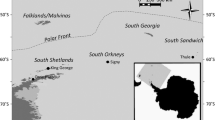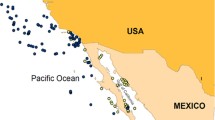Abstract
We examined the genetic structure of double-crested cormorants (Phalacrocorax auritus) across their range in the United States and Canada. Sequences of the mitochondrial control region were analyzed for 248 cormorants from 23 breeding sites. Variation was also examined at eight microsatellite loci for 409 cormorants from the same sites. The mitochondrial and microsatellite data provided strong evidence that the Alaskan subspecies (P. a. cincinnatus) is genetically divergent from other populations in North America (net sequence divergence = 5.85 %; ΦST for mitochondrial control region = 0.708; FST for microsatellite loci = 0.052). Historical records, contemporary population estimates, and field observations are consistent with recognition of the Alaskan subspecies as distinct and potentially of conservation interest. Our data also indicated the presence of another divergent lineage, associated with the southwestern portion of the species range, as evidenced by highly unique haplotypes sampled in southern California. In contrast, there was little support for recognition of subspecies within the conterminous U.S. and Canada. Rather than genetically distinct regions corresponding to the putative subspecies [P. a. albociliatus (Pacific), P. a. auritus (Interior and North Atlantic), and P. a. floridanus (Southeast)], we observed a distribution of genetic variation consistent with a pattern of isolation by distance. This pattern implies that genetic differences across the range are due to geographic distance, rather than discrete subspecific breaks. Although three of the four traditional subspecies were not genetically distinct, possible demographic separation, habitat differences, and documented declines at some colonies within the regions, suggests that the Pacific and possibly North Atlantic portions of the breeding range may warrant differential consideration from the Interior and Southeast breeding regions.





Similar content being viewed by others
References
Abbott CL, Double MC (2003) Phylogeography of shy and white-capped albatrosses inferred from mitochondrial DNA sequences: implications for population history and taxonomy. Mol Ecol 12:2747–2758
Akaike H (1974) A new look at the statistical model identification. IEEE Trans Automat Contr 19:716–723
American Ornithologists’ Union (1957) Check-list of North American birds. American Ornithologists’ Union, Washington, DC
Anderson CD, Roby DD, Collis K (2004) Conservation implications of the large colony of Double-crested Cormorants on East Sand Island, Columbia River estuary, Oregon, USA. Colon Waterbirds 27:155–160
Avise JC (2000) Phylogeography: the history and formation of species. Harvard University Press, Cambridge
Avise JC, Walker D, Johns GC (1998) Speciation durations and Pleistocene effects on vertebrate phylogeography. Proc R Soc Lond B 265:1707–1712
Bandelt HJ, Foster P, Rohl A (1999) Median-joining networks for inferring intraspecific phylogenies. Mol Biol Evol 16:37–48
Bédard J, Nadeau A, Lepage M (1995) Double-crested cormorant culling in the St. Lawrence River estuary. Colon Waterbird 18(S1):78–85
Bent AC (1922) Life Histories of North American petrels and pelicans and their allies. US National Museum Bulletin 121
Berg T, Moum T, Johansen S (1995) Variable numbers of simple tandem repeats make birds of the order Ciconiiformes heteroplasmic in their mitochondrial genomes. Curr Genet 27:257–262
British Columbia Conservation Data Centre (2008) BC species and ecosystems explorer. BC Mininstry of the Environment, Victoria, BC. Available at http://a100.gov.bc.ca/pub/eswp/. Accessed 12 May 2009
Burg T (2000) Genetic analyses of albatrosses: mating systems, population structure, and taxonomy. PhD thesis, Cambridge University, Cambridge
Capitolo PJ, Carter HR, Young RJ, McChesney GJ, McIver WR, Golightly RT, Gress F (2004) Changes in breeding population size of Brandt’s and Double-crested Cormorants in California, 1975–2003. Department of Wildlife, Humboldt State University, Arcata, California
Carter HR, Sowles AL, Rodway MS, Wilson UW, Lowe RW, McChesney GJ, Gress F, Anderson DL (1995) Changing population size, trends, and conservation problems of the Double-crested cormorant on the Pacific Coast of North America. Colon Waterbirds 18(S1):189–215
Clark AC, Kollasch TM, Williamson DA (2006) Movements of Double-crested Cormorants fledged on the Columbia River estuary. Northwest Nat 87:150–152
Desjardins P, Morais R (1990) Sequence and gene organization of the chicken mitochondrial genome: a novel gene order in higher vertebrates. J Mol Biol 212:599–634
Dolbeer RA (1991) Migration patterns of Double-crested Cormorants east of the Rocky Mountains. J Field Ornithol 62:83–93
Duffy DC (1995) Why is the Double-crested Cormorant a problem? Insights from cormorant ecology and human sociology. Colon Waterbirds 18(S1):25–32
Eckert CG, Samis KE, Lougheed SC (2008) Genetic variation across species’ geographical ranges: the central-marginal hypothesis and beyond. Mol Ecol 17:1170–1188
Evanno G, Regnaut S, Goudet J (2005) Detecting the number of clusters of individuals using the software STRUCTURE: a simulation study. Mol Ecol 14:2611–2620
Excoffier L, Laval G, Schneider S (2005) Arlequin ver. 3.0: an integrated software package for population genetics data analysis. Evol Bioinform Online 1:47–50
Forster P, Torroni A, Renfrew C, Rohl A (2001) Phylogenetic star contraction applied to Asian Papuan mtDNA evolution. Mol Biol Evol 18:1864–1881
Funk CW, Mullins TD, Haig SM (2007) Conservation genetics of snowy plovers (Charadrius alexandrinus) in the Western Hemisphere: population genetic structure and delineation of subspecies. Conserv Genet 8:1287–1309
Gaunt AS, Oring LW (1997) Guidelines to the use of wild birds in research. The Ornithological Council, Washington, DC
Goudet J (2001) FSTAT, a program to estimate and test gene diversities and fixation indices (version 2.9.3). http://www.unil.ch/izea/softwares/fstat.html. Accessed 27 Dec 2012
Green MC, Waits JL, Avery ML, Tobin ME, Leberg PL (2006) Microsatellite variation of Double-crested Cormorant populations in eastern North America. J Wildl Manage 2:579–583
Gress F, Risebrough RW, Anderson DW, Kiff LF, Jehl JR (1973) Reproductive failures of Double-crested Cormorants in southern California and Baja California. Wilson Bull 85:197–208
Gress F, Anderson DW, Ingram T, Carter HR (1995) Reproductive performance and breeding population size of Brown Pelicans and Double-crested Cormorants in the Southern California Bight, 1990–1994. California Department of Fish and Game, Sacramento, California (unpublished report)
Guillaumet A et al (2011) Determinants of local and migratory movements of Great Lakes double-crested cormorants. Behav Ecol 10:1096–1103
Haig SM, Mullins TD, Forsman ED (2004) Subspecific relationships and genetic structure in the Spotted Owl. Conserv Genet 5:683–705
Hall T (2001) BioEdit. North Carolina State University, Raleigh
Hatch JJ (1995) Changing populations of Double-crested Cormorants. Colon Waterbirds 18(S1):8–24
Hatch JJ, Weseloh DV (1999) The Double-crested Cormorant (Phalacrocorax auritus). In: Poole A, Gill F (eds) Birds of North America No. 441. The Birds of North America Inc., Philadelphia
Hewitt GM (1996) Some genetic consequences of ice ages, and their role in divergence and speciation. Biol J Linn Soc 58:247–276
Huelsenbeck JP, Ronquist F (2001) MRBAYES: bayesian inference of phylogenetic trees. Bioinformatics 17:754–755
Kimura M (1983) The neutral theory of molecular evolution. Cambridge University Press, Cambridge
King TD, Blackwell B, Dorr B (2010) Effects of aquaculture on migration and movement patterns of double-crested cormorants. Hum Wildl Confl 4:77–86
Krohn WB, Allen RB, Moring JR, Hutcinson AE (1995) Double-crested cormorants in New England: population and management histories. Colon Waterbird 18(S1):8–24
Mantel N (1967) The detection of disease clustering and a generalized regression approach. Cancer Res 27:209–220
Mercer DM, Haig SM, Mullins TD (2010) Isolation and characterization of 8 novel microsatellite loci in the double-crested cormorant (Phalacrocorax auritus). Conserv Genet Resour 2:119–121
Mills LS, Allendorf FW (1996) The one-migrant-per-generation rule in conservation and management. Conserv Biol 10:1509–1518
Moritz C (1994a) Application of mitochondrial DNA analysis in conservation: a critical review. Mol Ecol 3:401–411
Moritz C (1994b) Defining ‘evolutionary significant units’ for conservation. Trends Ecol Evol 9:373–375
Moul IE, Gebauer MB (2002) Status of the Double-crested Cormorant in British Columbia, B.C. Ministry of Water, Land, and Air Protection, Biodiversity Branch, Victoria, BC. Wildlife Working Report No. WR-105
Oosterhout CV, Hutchinson WF, Willis DPM, Shipley P (2004) MICRO-CHECKER: software for identifying and correcting genotyping errors in microsatellite data. Mol Ecol Notes 4:535–538
Palmer RS (1962) Handbook of North American birds, vol 1. Yale University Press, New Haven
Peakall R, Smouse PE (2012) GENALEX 6.5: genetic analysis in Excel. Population genetic software for teaching and research-an update. Bioinformatics 28:2537–2539
Petit RJ, Aguinagalde I, de Beaulieu J-L et al (2003) Glacial refugia: hot spots but not melting pots of genetic diversity. Science 300:1563–1565
Piertney SB, Goostrey A, Dallas JF, Carss DN (1998) Highly polymorphic microsatellite markers in the great cormorant Phalacrocorax carbo. Mol Ecol 7:138–140
Posada D, Crandall KA (1998) MODELTEST: testing the model of DNA substitution. Bioinformatics (Oxford) 14:817–818
Pritchard JK, Stephens M, Donnelly P (2000) Inference of population structure using multilocus genotype data. Genetics 155:945–959
Raymond M, Rousset F (1995) GENEPOP (Version 1.2): population genetics software for exact tests and ecumenicism. J Hered 86:248–249
Rice WR (1989) Analyzing tables of statistical tests. Evolution 43:223–225
Scherr H, Bowman J, Abraham K (2010) Migration and wintering movements of double-crested cormorants breeding in Georgian Bay, Ontario. Waterbirds 33:451–460
Slatkin M (1985) Gene flow in natural populations. Annu Rev Ecol Evol Syst 16:393–430
Sorenson MD, Fleischer RC (1996) Multiple independent transposition mitochondrial DNA control region sequences to the nucleus. Proc Natl Acad Sci USA 93:15239–15243
Sorenson MD, Ast JC, Dimcheff DE, Yuri T, Mindell DP (1999) Primers for a PCR-based approach to mitochondrial genome sequencing in birds and other vertebrates. Mol Phylogenet Evol 12:105–114
Sullivan J, Abdo Z, Joyce P, Swofford DL (2005) Comparing successive approximations and simultaneous optimization approaches to maximum likelihood estimation of phylogeny from DNA sequences. Mol Biol Evol 22:1386–1392
Swofford DL (2000) PAUP*: phylogenetic analysis using parsimony (*and Other Methods). Sinauer, Sunderland
Tajima F (1989) Statistical method for testing the neutral mutation hypothesis by DNA polymorphism. Genetics 123:585–595
Tamura K, Nei M (1993) Estimation of the number of nucleotide substitutions in the control region of mitochondrial DNA in humans and chimpanzees. Mol Biol Evol 10:512–526
Trapp JL, Dwyer TJ, Doggett JJ, Nickum JG (1995) Management responsibilities and policies for cormorants: United States Fish and Wildlife Service. Colon Waterbirds 18(S1):226–230
Tyson LA, Belant JL, Cuthbert FJ, Weseloh DV (1999) Nesting populations of Double-crested Cormorants in the United States and Canada. In: Tobin ME (ed) Proceedings of the symposium on double-crested cormorants: population status and management issues in the Mid-west, USDA/APHIS Technical Bulletin No. 1879. USDA/APHIS, Washington, DC, pp 17–26
USDI/FWS (2003a) Migratory bird permits; regulations for Double-crested Cormorant management, Proposed rule. Fed Reg 68:12653–12660
USDI/FWS (2003b) Final environmental impact statement: Double-crested Cormorant management in the United States. Prepared by USDI/FWS, in cooperation with USDA/APHIS/WS, 2003
Waits JL, Avery ML, Tobin ME, Leberg PL (2003) Low mitochondrial DNA variation in Double-crested Cormorants in Eastern North America. Colon Waterbirds 26:196–200
Weseloh DV, Ewins PJ, Struger J, Mineau P, Bishop CA, Postupalsky S, Ludwig JP (1995) Double-crested Cormorants of the Great Lakes: changes in population size, breeding distribution and reproductive output between 1913 and 1991. Colon Waterbirds 18(S1):48–59
Wires LR, Cuthbert FJ (2006) Historic Populations of the Double-crested Cormorant (Phalacrocorax auritus): implications for conservation and management in the 21st century. Colon Waterbirds 29:9–37
Wright S (1931) Evolution in Mendelian populations. Genetics 16:97–259
Wright S (1943) Isolation by distance. Genetics 28:139–156
Acknowledgments
We thank the U.S. Geological Survey (USGS) Forest and Rangeland Ecosystem Science Center (FRESC), U.S. Army Corps of Engineers, Portland District, and Bonneville Power Administration for providing funding. The U.S. Fish and Wildlife Service, the Canadian Wildlife Service, and the U.S. Department of Agriculture’s Animal and Plant Health Inspection Service and Wildlife Service were all instrumental in facilitating and obtaining cormorant samples. Many individuals contributed samples to this study, and we are grateful to everyone who provided samples or assisted with sample collection. Any use of trade, product, or firm names is for descriptive purposes only and does not imply endorsement by the U.S. Government.
Author information
Authors and Affiliations
Corresponding author
Electronic supplementary material
Below is the link to the electronic supplementary material.
Rights and permissions
About this article
Cite this article
Mercer, D.M., Haig, S.M. & Roby, D.D. Phylogeography and population genetic structure of double-crested cormorants (Phalacrocorax auritus). Conserv Genet 14, 823–836 (2013). https://doi.org/10.1007/s10592-013-0477-8
Received:
Accepted:
Published:
Issue Date:
DOI: https://doi.org/10.1007/s10592-013-0477-8




